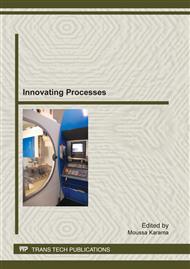[1]
Whitney JM. Experimental characterization of delamination fracture. In: Pagano NJ, editor. Interlaminar response of composite materials, Composite Material series 5. New York: Elsevier Science, (1989).
DOI: 10.1016/b978-0-444-87285-2.50008-x
Google Scholar
[2]
Tamuzs V, Tarasovs S, Vilks U. Delamination properties of translaminar reinforced composites. Composites Science and Technology 2003; 63: 1423–1431.
DOI: 10.1016/s0266-3538(03)00042-3
Google Scholar
[3]
Ko FK. Three-dimensional fabric for composite. In: Chou, TW, Ko FK, editors. Textile structural composite. New York: Elsevier, (1989).
Google Scholar
[4]
Jain LK, Dransfield KA, Mai Y-W. Effect of reinforcing tabs on the Mode I delamination toughness of stitched CFRPs. Journal of Composite Materials 1998; 32(22): 2016–41.
DOI: 10.1177/002199839803202202
Google Scholar
[5]
Dransfield KA, Jain LK, Mai Y-W. On the effects of stitching in CFRPs-I. Mode I delamination toughness. Composites Science and Technology 1998; 58(6): 815–27.
DOI: 10.1016/s0266-3538(97)00229-7
Google Scholar
[6]
Jain LK, Yiu-Wing Mai. On the effect of stitching on Mode I delamination toughness of laminated composites. Composites Science and Technology 1994; 51(3): 331–45.
DOI: 10.1016/0266-3538(94)90103-1
Google Scholar
[7]
Rugg KL, Cox BN, Massabo R. Mixed mode delamination of polymer composite laminates reinforced through the thickness by z-fibers. Composites Part A 2002; 33: 177–90.
DOI: 10.1016/s1359-835x(01)00109-9
Google Scholar
[8]
Tong L, Mouritz AP, Banninster MK. 3D fibre reinforced polymer composites. Elsevier; (2002).
Google Scholar
[9]
Partridge IK, Cartié DDR. Delamination resistant laminates by Z-Fiber_ pinning. Part I Manufacture and fracture performance. Composites Part A 2005; 35: 55–64.
DOI: 10.1016/s1359-835x(04)00180-0
Google Scholar
[10]
Whitney JM. Experimental characterization of delamination fracture. In: Pagano NJ, editor. Interlaminar response of composite materials, Composite Material series 5. New York: Elsevier Science, (1989).
DOI: 10.1016/b978-0-444-87285-2.50008-x
Google Scholar
[11]
ASTM D 5528-94a, 1997. Standard test method for Mode I interlaminar fracture toughness,. Annual book of ASTM standards, 1997, no. 15. 03.
Google Scholar
[12]
Mouritz A.P., Baini C. et Herszberg I. Mode I interlaminar fracture toughness properties of advanced textile fibreglass composites, Composites Part A, 1999, v. 30, p.859–870.
DOI: 10.1016/s1359-835x(98)00197-3
Google Scholar
[13]
Falconnet D., Bourban P. -E., Pandita S., Manson J. -A. E., Verpoest I. Fracture toughness of weft-knitted fabric composites, Composites Part B, 2002, v. 33, no. 8, pp.579-588.
DOI: 10.1016/s1359-8368(02)00053-7
Google Scholar
[14]
Guenon VA, Chou T-W, Gillespie JW. Toughness properties of a three-dimensional carbon-epoxy composite,. Journal of Materials Science, 1989; 24: 4168.
DOI: 10.1007/bf01168991
Google Scholar
[15]
Geubelle P. H. and Baylor J. S. Impact-induced delamination of composites: a 2d simulation. Composites Part B, 1998, 29B: 589-602.
DOI: 10.1016/s1359-8368(98)00013-4
Google Scholar
[16]
De Moura M. F. S. F., Conalves J. P., Marques A. T. and de Castro P. T. Prediction of compressive strength of carbon-epoxy laminates containing delaminations by using a mixed-mode damage model. Composite Structures, 2000, 50: 151-157.
DOI: 10.1016/s0263-8223(00)00091-x
Google Scholar
[17]
Camanho P. P. and Davila C. G. Mixed-mode decohesion finite elements for the simulation of delamination in composite materials. Technical Memorandum-2002-211737, NASA Langley Research Center, (2002).
Google Scholar
[18]
Turon A., Davila C. G., Camanho P. P., and Costa J. An engineering solution for using coarse meshes in the simultaion of delamination with cohesive zone model. Technical Memorandum-2005-213547, NASA Langley Research Center, (2005).
Google Scholar
[19]
Campilho R. D. S. G., de Moura M. F. S. F. and Domingues J. J. M. S. Modelling single and double-lap repairs on composite materials. Composites Science and Technology, 2005, 65: 1948-(1958).
DOI: 10.1016/j.compscitech.2005.04.007
Google Scholar
[20]
Reeder JR. An evaluation of mixed-Mode delamination failure criteria. Technical Memorandum-1992-104210, NASA Langley Research Center, (1992).
Google Scholar
[21]
Mazars J. Application de la mécanique de l'endommagement au comportement non linéaire et la rupture du béton de structure. PhD thesis, Université de Paris 6, 61, Av. PDT Wilson - 94230 Cachan - France, 1984. In French.
DOI: 10.1051/978-2-7598-0239-5-012
Google Scholar
[22]
Turon A., Davila C. G., Camanho P. P., and Costa J. An engineering solution for using coarse meshes in the simultaion of delamination with cohesive zone model. Technical Memorandum-2005-213547, NASA Langley Research Center, (2005).
Google Scholar
[23]
Reeder JR. An evaluation of mixed-Mode delamination failure criteria. Technical Memorandum-1992-104210, NASA Langley Research Center, (1992).
Google Scholar
[24]
Zou Z., Reid S. R. and Li S. A continuum damage Model for delaminations in laminated composites. Mechanics and Physics of Solids, 2003, 51: 333-356.
DOI: 10.1016/s0022-5096(02)00075-3
Google Scholar


